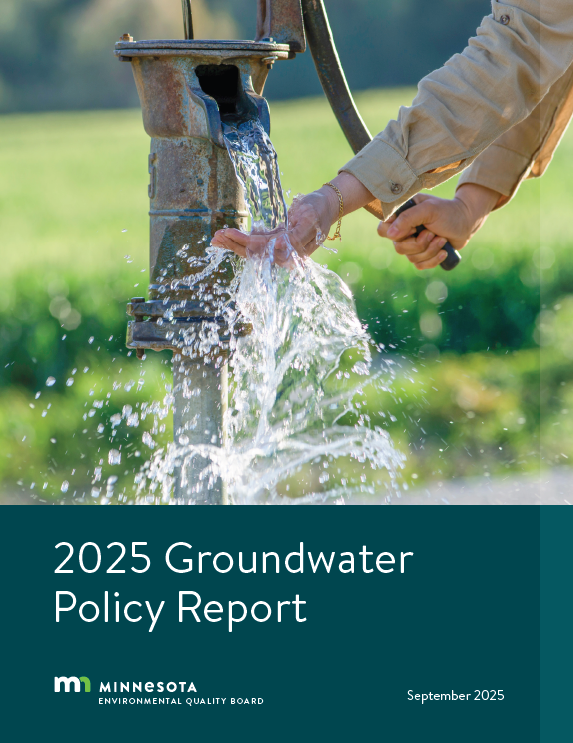When people think of Minnesota, they think of water. We are the land of 10,000 lakes and Mnísota Makhóche – land where the water meets the sky.
Responsibility for the protection of Minnesota’s surface and groundwater quality and quantity are distributed across many state agencies. The Environmental Quality Board is charged with coordinating state water resource management activities. It is responsible for developing the state water plan, a state water monitoring plan, biennial water policy and priorities reports, and biennial reports on trends in water quality and availability and research needs.
Stay up to date on our reporting and program work by signing up on our EQB Water Program email list.
Ongoing coordination
The EQB is responsible for consolidating and presenting the state’s assessment of water quality (both surface and groundwater) and water quantity on every five-year basis (Minn. Stat. 103A.43). In addition, the EQB prepares a report on the policy issues related to coordination of state groundwater programs and every ten-year state water plan.
2025 Groundwater Policy Report
EQB is required (by Minn. Stat. 103A.204) to report to the legislature on policy issues related to its responsibilities for “coordination of state groundwater protection programs” and to compile three specific appendices (prepared by MPCA, MDA, and DNR with the help of other agencies) that fulfill the requirements of Minn. Stat. 103A.43.
The 2025 groundwater policy report also supports informed decision making on groundwater issues by:
- Providing foundational information about groundwater in Minnesota
- Describing the state’s collaborative approach to ensuring Minnesota has enough clean groundwater
- Describing important threats to Minnesota’s groundwater and the actions being taken to mitigate those threats - including showcasing success
- Identifying gaps and opportunities to be addressed if we want to continuously improve our approaches to mitigating the threats
Download or view the report and appendices below:
State Water Plan
According to Minnesota Statutes 103B.151, the Environmental Quality Board is to coordinate a comprehensive long-range water resources plan for the state every ten years.
The 2020 state water plan focused on the intersection of water and climate. The purpose of the plan is to establish a framework for aligning state agencies, legislative priorities, and local government policy, programs, and actions for the coming decade. The plan sets forth multiple strategies within five goal areas:
- Goal 1: Ensure Drinking Water is Safe and Sufficient
- Goal 2: Manage landscapes to protect and improve water quality
- Goal 3: Manage built environments and infrastructure for greater resiliency
- Goal 4: Manage landscape to hold water and reduce runoff
- Goal 5: Promote resiliency in quality of life
Download or view the report here:
Appendix:
Prior Reports
Beyond the Status Quo: 2015 EQB Water Policy Report
This report is the result of collaboration across state agencies to to move beyond the status quo on water challenges. This report was required by Minnesota Statutes 103A.204 and 103A.43.
The EQB’s Water Policy Report is organized as a menu of options to move beyond the status quo on water challenges. It provides a framework to continue a broad conversation on water policy with local and state implementation partners. The report includes voluntary and regulatory solutions as well as proposing system changes that harness market forces and look to change cultural expectations. Finally, in some areas, more study is needed to best determine how we take action.
The EQB’s Water Policy Report focuses on addressing issues including stewardship of water resources, the management of the built environment, increasing the living cover across watersheds, and helping Minnesota remain resilient to extreme rainfall. Key findings from the report include:
- Minnesota is a Global Leader in Water – We are a global leader in production of technology to treat, reuse, and conserve water. This leadership results from the intersection of our entrepreneurs, cutting-edge research and development, a world-class education system, and a cluster of innovative industries.
- Land Usage Affects Our Water – The choices landowners make on the landscape determine whether it is able to hold the soil, absorb rainfall, and filter nutrients. Similarly, the choices we make in the built environment affect how water drains off roads and other impervious surfaces, carrying contaminants that can impair water quality.
- Land Usage Results in Significant Costs – Building in floodplains and human changes to watersheds that increase runoff combine to increase flood damages. Pollutants make public waters unfit for consumption, swimming, or fishing.
Download or view the report here:
Appendix:
Minnesota’s Water Industry Economic Profile
The Agricultural BMP Handbook for Minnesota
Water Availability Report (2015)
This report was prepared by the EQB, with the Board of Water and Soil Resources, Department of Agriculture, Department of Employment and Economic Development, Department of Health, Department of Natural Resources, Department of Transportation, Metropolitan Council, and Pollution Control Agency.
A ten year framework for managing Minnesota's water
- Brief summary of Minnesota's efforts to coordinate and integrate water programs, May 1, 1991.